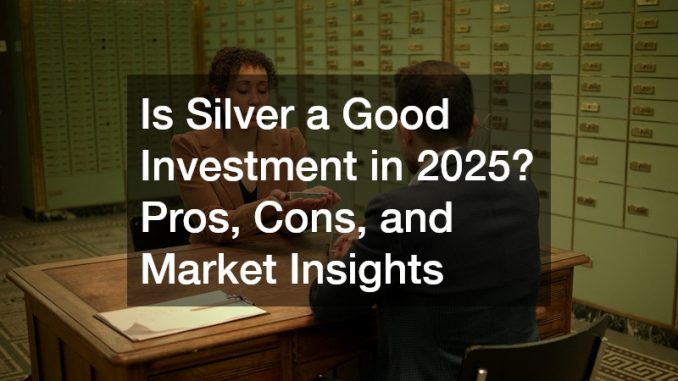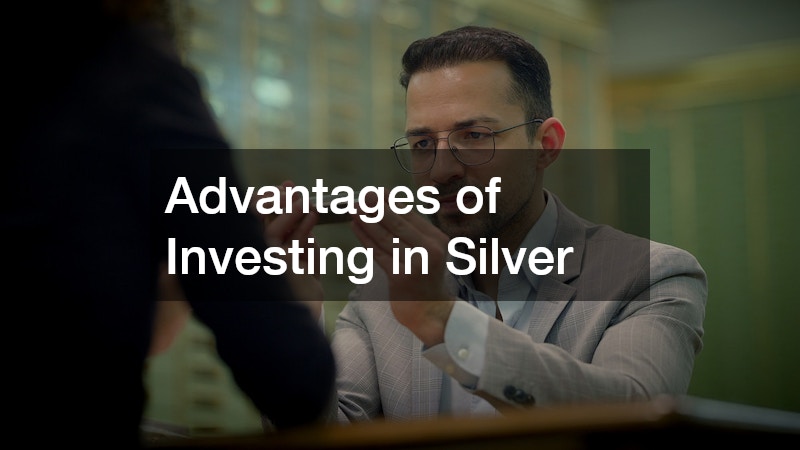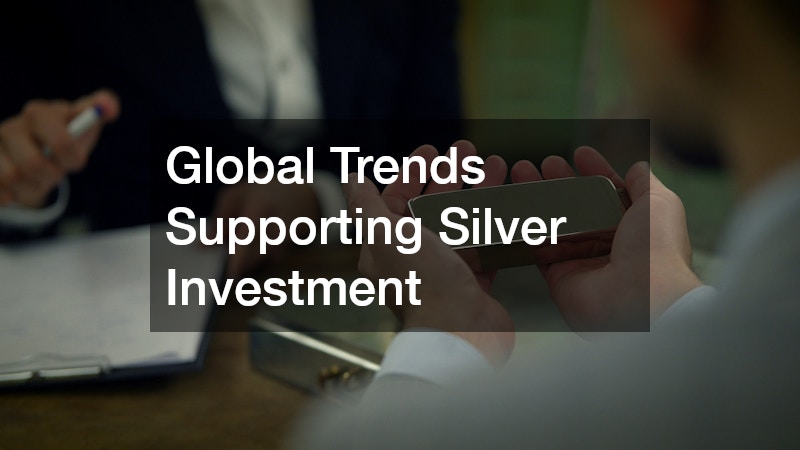

As we navigate through 2025, silver has emerged as a focal point for investors seeking diversification and potential growth. With its unique position as both a precious and industrial metal, silver offers a blend of safety and opportunity. This article delves into the current market dynamics, advantages, and potential drawbacks of investing in silver this year.
The investment landscape in 2025 is marked by heightened economic uncertainty, geopolitical tensions, and rapid technological advancement. Central banks continue to grapple with inflation, interest rate adjustments, and slowing global growth, prompting many investors to reassess traditional asset allocations. In this climate, silver has gained renewed attention—not only for its historical role as a store of value but also for its rising industrial relevance.
Silver’s appeal is no longer confined to collectors or bullion enthusiasts. With demand surging in green technologies like solar energy, electric vehicles, and electronics manufacturing, silver now sits at the intersection of sustainability and profitability. At the same time, its affordability compared to gold makes it an accessible entry point for retail investors. Whether you’re a seasoned investor or someone exploring alternatives to stocks and bonds, understanding silver’s multifaceted role in today’s economy is key to making informed decisions in a volatile market.
Silver Market Overview in 2025
Silver prices have experienced notable fluctuations in 2025. Starting the year at $29.29 per ounce, silver has risen to approximately $33.40, marking a 14% increase. Analysts predict further growth, with some forecasts suggesting prices could reach $40 per ounce by Q3 2025.
Key Factors Influencing Silver Prices
- Industrial Demand:
Silver’s growing role in the green energy transition—especially in solar panel production, electronics, and electric vehicles (EVs)—has been a primary driver of its rising value. As global efforts to achieve net-zero emissions intensify, silver’s demand is expected to remain robust. - Supply Constraints:
A combination of mining slowdowns, regulatory challenges, and limited recycling infrastructure has led to a projected supply deficit of approximately 117 million ounces this year. This imbalance between demand and supply is likely to push prices even higher. - Economic Factors:
Inflation, geopolitical tensions, and uncertainty in equity markets have prompted investors to seek safe-haven assets. While gold has traditionally held that role, silver is now increasingly viewed as a more affordable alternative.
Advantages of Investing in Silver

Silver offers several benefits that make it an attractive investment option in 2025:
1. Affordability
Compared to gold, silver is more accessible to retail investors due to its lower price per ounce. This allows smaller investors to accumulate significant holdings without needing a large initial capital outlay.
2. Portfolio Diversification
Silver’s price movements are not always correlated with stocks, bonds, or even gold, making it a useful tool for reducing overall portfolio volatility. It can serve as a hedge during economic downturns and periods of rising inflation.
3. Industrial Utility
Silver is essential in several industries beyond jewelry and investment—medical devices, semiconductors, batteries, and photovoltaic cells all use silver. This dual demand (investment + industrial) provides a stabilizing base of support for its value.
4. Hedge Against Inflation
Like other tangible assets, silver has historically retained value during inflationary periods. As fiat currencies lose purchasing power, precious metals often gain popularity among investors looking to preserve wealth.
Potential Drawbacks of Silver Investment
Despite its advantages, silver investment comes with its own set of risks and considerations:
1. Price Volatility
Silver prices can be more volatile than gold, often reacting sharply to macroeconomic news and shifts in investor sentiment. While this can mean upside potential, it also introduces greater downside risk in the short term.
2. Storage and Insurance Costs
Owning physical silver means additional costs related to secure storage and insurance. These costs can eat into your overall returns, especially for long-term holders of physical bullion.
3. Liquidity Concerns
Unlike stocks or ETFs, selling physical silver quickly, especially in large quantities or during market panics, can be challenging. Finding a buyer willing to pay fair market value may not always be immediate.
4. Tax Implications
In some countries, capital gains taxes on silver are higher than for other assets. For instance, in the U.S., silver is classified as a collectible, subject to a higher long-term capital gains tax rate of 28%, compared to 15–20% for stocks.
Comparing Silver to Other Investment Assets
Silver vs. Gold
While both are precious metals, silver often experiences higher percentage swings due to its smaller market size and dual usage (investment + industrial). Gold is more stable and traditionally viewed as the go-to store of value, but silver can outperform gold in bull markets due to greater volatility.
Silver vs. Stocks and Bonds
Stocks offer dividends and capital appreciation, while bonds offer interest payments and lower volatility. Silver provides neither income nor guaranteed growth—it’s a pure play on capital appreciation and wealth preservation.
Silver vs. Real Estate
Real estate investments offer rental income and tax benefits, but come with high entry costs and liquidity challenges. Silver, on the other hand, is easily divisible, transportable, and liquid—especially in ETF form—but doesn’t generate passive income.
Is Silver a Good Investment This Year?
Considering current market trends, silver presents a compelling investment opportunity this year. The convergence of industrial demand, tightening supply, inflationary pressures, and economic uncertainty makes a strong case for including silver in a well-diversified portfolio.
However, investors should weigh the trade-offs between physical and paper silver, understand market risks, and avoid overexposure.
Ways to Invest in Silver
There are several routes for investors to gain exposure to silver, depending on risk tolerance and investment goals:
1. Physical Silver
Silver bars and coins offer direct ownership and are considered the safest form of investment by many. However, they come with storage, transportation, and insurance costs.
- Popular options: American Silver Eagles, Canadian Silver Maple Leafs, and silver bullion bars.
- Best for: Long-term holders, preppers, and those concerned about financial system risk.
2. Silver Exchange-Traded Funds (ETFs)
ETFs provide exposure to silver prices without the hassles of storing physical metal.
- Best for: Investors looking for liquidity and easy portfolio integration.
- Pros: Low fees, easy to buy/sell, no physical storage.
- Cons: Counterparty risk, management fees, no tangible ownership.
3. Silver Mining Stocks
Investing in silver mining companies offers leverage to silver prices, as these companies often outperform when silver rises.
- Examples: First Majestic Silver Corp (AG), Pan American Silver (PAAS), Wheaton Precious Metals (WPM).
- Best for: Growth-oriented investors willing to take on more risk.
- Risks: Operational challenges, geopolitical exposure, management issues.
4. Silver Futures and Options
Futures and options allow leveraged trading of silver, which can amplify both gains and losses. These instruments are best left to advanced investors or traders.
- Best for: Short-term strategies, hedging, or speculative trades.
- Risks: High volatility, potential margin calls, time decay.
Global Trends Supporting Silver Investment

Green Energy Policies
Governments worldwide are pushing for clean energy adoption, particularly solar. Silver is a key component in photovoltaic cells, and demand from this sector alone is projected to exceed 160 million ounces in 2025.
Electric Vehicle (EV) Expansion
Each EV uses 25–50 grams of silver. With EV adoption accelerating globally, especially in China and Europe, silver is poised to benefit from sustained demand.
De-Dollarization and Currency Risk
As nations diversify away from the U.S. dollar, precious metals like silver gain appeal. Central banks have been increasing their exposure to gold, and while silver is not held in reserve to the same extent, the trend supports broader precious metals momentum.
Expert Opinions on Silver in 2025
Goldman Sachs and JP Morgan have both raised their outlooks for silver, citing robust industrial demand and limited new mining capacity. Some analysts even suggest silver could outperform gold in the next commodity supercycle.
Jeffrey Christian, Managing Partner at CPM Group, recently commented:
“Silver is not just a hedge, it’s a hybrid. Its value lies in its industrial demand as much as its role as money.”
Short-Term vs. Long-Term Outlook
Short-Term (Next 6–12 Months)
Silver is likely to remain volatile as markets respond to inflation data, Fed decisions, and geopolitical tensions. Prices could range between $30–$40, depending on macroeconomic conditions and investor sentiment.
Long-Term (Beyond 2025)
Over the next decade, silver’s role in the energy transition, emerging tech, and global monetary uncertainty could see its value rise substantially. Long-term holders could benefit from both capital appreciation and stability.
Final Thoughts
In 2025, silver stands out as a multifaceted investment. Its affordability, growing industrial utility, and historical role as an inflation hedge make it appealing to a wide range of investors. Whether you’re looking to diversify your portfolio, hedge against economic risk, or capitalize on green energy trends, silver presents a viable option.
Beyond its traditional uses, silver is gaining momentum as a strategic asset in the transition to a low-carbon economy. The increasing adoption of electric vehicles, expansion of solar energy infrastructure, and demand for advanced electronics all contribute to robust, long-term industrial demand.
Additionally, silver’s relative undervaluation compared to gold suggests potential for price appreciation. For both conservative investors seeking stability and risk-tolerant individuals aiming for growth, silver offers flexibility in how it can be incorporated into a broader investment strategy. As global markets continue to evolve, silver’s dual nature as both a commodity and a monetary asset positions it as a compelling choice in uncertain times.
Investment Tips:
- Diversify your silver exposure: combine physical silver with ETFs or mining stocks.
- Monitor market trends: stay informed about inflation data, green energy initiatives, and central bank policies.
- Know your exit strategy: define your investment horizon and price targets.
As with any asset, success lies in strategic entry, disciplined risk management, and a long-term view. Silver may not be a guaranteed winner, but in the shifting landscape of 2025, it certainly deserves a closer look.